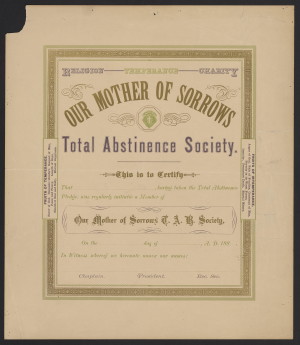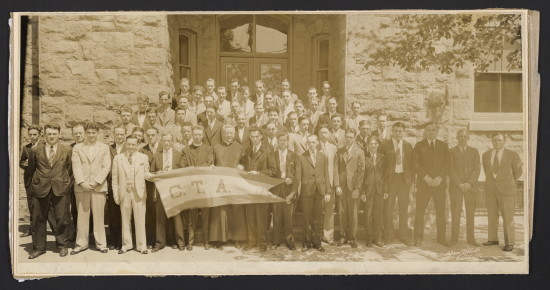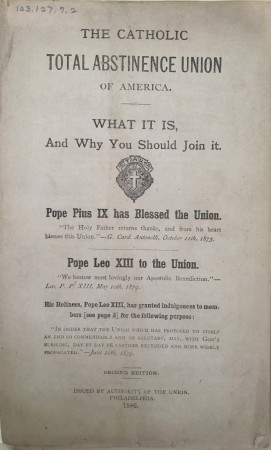
Our Mother of Sorrows Total Abstinence Society https://omeka.chrc-phila.org/items/show/7090
Temperance movements have a long tradition in the United States, with the aim to not only eliminate drinking but to also improve the fabric of America. The first temperance society formed in 1789 in Connecticut and throughout the 19th century they spread across the country.[1] By 1841 there were 26 temperance and abstinence societies operating in Philadelphia alone.[2] One of those societies was the Total Abstinence Society, a Catholic organization founded in 1840 by an Augustinian priest named Moriarty.
Increasingly Catholic temperance societies become more popular, partly due to the effects of Father Matthew, a priest who helped start the temperance movement in Ireland and then traveled America from 1849-1851 to spread the cause.[3] With the growth in local societies, usually based around either parishes or dioceses, the need for a unifying national organization arose. So in 1872 in Baltimore, a national convention was held with 177 societies representing over 26,000 members.[4] It was here that the Catholic Total Abstinence Union of America (CTAU) was formed to help in establishing directives for both temperance and benevolence activities. An interesting side note, the proposed name first included “of the United States” instead “of America” but objections from Canadian societies also in attendance resulted in the change.[5]

Catholic Total Abstinence Union https://omeka.chrc-phila.org/items/show/7025
Members of the union pledged to “abstain from… the sin of intemperance” and to “change the wretched abode of the drunkard into a home of peace and prosperity,” highlighting the belief that drinking not only threatened the salvation of the soul but also endangered the functioning of society.[6] In addition to the national union, many societies also created regional unions as well. For instance, the Catholic Total Abstinence Union of the Diocese of Philadelphia formed in March of 1872, comprising of two societies and 150 members.[7]
In order to fulfill its mission and pledge, the CTAU relied on public rallies in order to gain support and convince people to give up alcohol. In addition, the union made use of numerous newspapers, such as Boston’s The Pilot or New York's Catholic Society Journal of America in order to spread the message of temperance.[8] Another way that the CTAU and other temperance societies tried to increase abstinence was through the building of public drinking fountains, as they believed that better access to clean water would keep the poor from turning to beer and liquor. Indeed, a fountain in New York declared that “There is no poison in my cup! Drink and Live,” which illustrates the concern that without clean water to drink, the people would continue to drink the poison of alcohol.[9] (The building of the most famous CTAU fountain, the Continental Fountain will be discussed in a future blog.)
The membership of the CTAU continued to grow during its early years, gaining an additional 400 society branches by 1876. However, the following year the union complained about a fall in per capita members, blaming it on the growing acceptance of abstinence and thus decrease in need for the societies.[10] This decrease likely influenced the CTAU’s decision to allow women societies to become honorary members in 1878 and then full active members by 1880; although they had to send male delegates to the annual convention.[11] Membership began to increase by the turn of the century, with over 1,000 societies associated with the CTAU, giving them a membership of over 66,000.[12]

President Roosevelt speaking before C.T.A.U. delegates and United Mine Workers of America http://www.loc.gov/pictures/item/2013647511/resource/
One of the largest events held by the CTAU was the 1905 annual convention in Wilkes-Barre, PA when President Teddy Roosevelt spoke as the keynote to over 80,000 people. The Catholic Total Abstinence Union continued have its annual meetings even after the passing of the 18th amendment, which outlawed the production and sale of alcohol. After the 21st amendment repealed Prohibition, the CTAU continued to function well into the mid twentieth century. While total abstinence failed to take hold as national policy, the rise of temperance societies, including Catholic Total Abstinence Union, are an important chapter in the history of the United States.

Annual Convention, Catholic Total Abstinence Union of America, August 9, 1939 https://omeka.chrc-phila.org/items/show/6871
To learn more of the CTAU come to the archives to see the papers, ephemera, and photos. See our online catalog for a list of material.
-
[1] Joseph Gibbs, History of the Catholic Total Abstinence Union of America, (Philadelphia: 1907), 11.
-
[2] Daria Gasparini, “A Celebration of Moral Force: The Catholic Total Abstinence Union of American Centennial Fountain,” Master’s Thesis (University of Pennsylvania, 2002), 47.
-
[3] Ibid., 47.
-
[4] Ibid., 49.
-
[5] Gibbs, History of the Catholic, 19.
-
[6] Gasparini, “A Celebration of Moral Force,” 49.
-
[7] Ibid. 50.
-
[8] Ibid., 51.
-
[9] Ibid., 53.
-
[10] Gibbs, History of the Catholic, 42 & 44.
-
[11] Ibid., 49 & 58.
-
[12] Ibid., 159.


